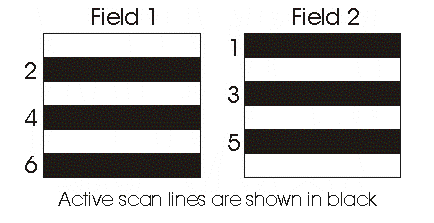High Definition Television
Terms:
- SDTV - Standard Definition Television
- EDTV - Enhanced Definition Television
- HDTV - High Definition Television
SDTV
As of the time of writing most television sources officially available in the UK are standard definition. Each frame we see is divided into 720 columns and 576 lines of data. The source equipment we use in the UK (from a normal aerial, VCR or cable/satellite receiver) transmits each frame to the display in interlaced format. In other words each frame is divided into 2 fields. The even numbered scan lines are in the first field and the odd lines are in the second:
So, for a standard CRT (cathode ray tube) television, each frame requires two passes of the electron gun, the first pass "draws" field 1 and the second pass draws field 2.
The PAL format is actually made up of 625 line but only 576 lines are used so that televisions have time for the electron gun to reset to itís home position. A useful result of this is that broadcasters can use the spare line for teletext.
EDTV
All projectors, plasma screens, lcd screens etc. are pixel based displays (as opposed to CRT being raster based). The result of this is that they are only able to display a "progressive" image. In other words, the interlaced fields mentioned for SDTV need to be recombined to create a progressive (line by line) frame. All pixel based displays have this in common, so they all need to have built in de-interlacers. One way of improving the picture quality is to us an external de-interlacer which will supply the display with a progressive image, the idea being that the external unit will do a better job of de-interlacing than the display built in unit.So, a progressive image is known as EDTV.
HDTV
This is the latest set of standards now becoming available. There are two flavours currently being used 720p and 1080. Of these 1080 offers the higher resolution at 1920*1080 against 720p's 1280*720 but 1080 is sometimes an interlaced format (known as 1080i, the bandwidth required is too high to offer progressive) which means it is susceptible to the same interlacing artifacts as the 576i system we currently use. This means that whilst 1080i offers more detail for still or slow moving objects, 720p will appear smoother for fast action shots. The ideal, used in HD-DVD and BluRay is 1080p, a progressive rather than interlaced signal.So where does this leave the home cinema buyer?
With 720 and 1080 doing battle over the next few years, what projector/plasma/lcd TV should you purchase?
At the moment, most of the source material we watch in the UK comprises of 576 line of data, which makes the current crop of 576 line DLP projectors highly attractive as no vertical scaling is required for DVD's, satellite, free-to-air broadcasts etc. Because of this relatively low resolution, SD (standard definition) display devices will often give a better picture than HD (high definition) devices, which require up-scaling.
The only potential problem is once HD becomes more readily available the lower resolution devices will need to down-scale the source to match their resolutions. This is something to consider when deciding which display best suits your needs however it needn't be the only factor as HD sources will generally downscale better than SD will upscale so other factors should be considered.
A more future proof idea is to purchase a display capable of natively supporting HD. The number of displays on the market that are high enough resolution to natively support 1080 is relatively few but 720p is supported by any device which has a vertical resolution of 720 lines or greater. Where the "HD Ready" column in our Home Cinema and Video Projectors section is ticked you are futures proofed to at least 720 standard.
In order to ensure you are HD ready, make sure the
 is displayed on the product page.
is displayed on the product page.
Some foundation figures:
- SDTV: 720*576i pixels, totaling 414720 pixels.
- EDTV: 720*576p pixels, totaling 414720 pixels.
- HDTV: 1280*720p pixels, totaling 921600 pixels or 1920*1080 pixels, totaling 2073600 pixels.
©Ken Davies, Ivojo Multimedia Ltd.